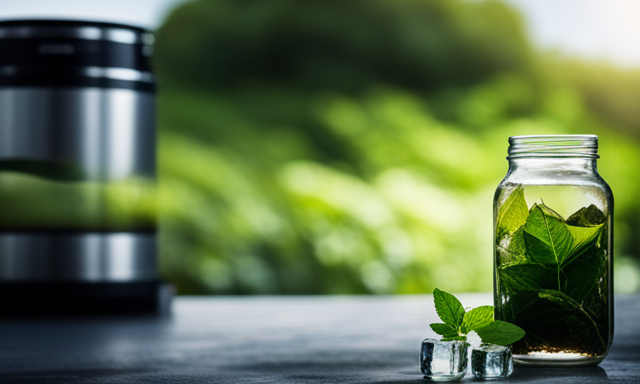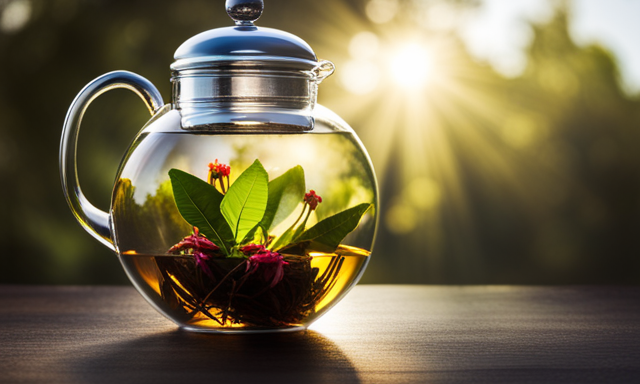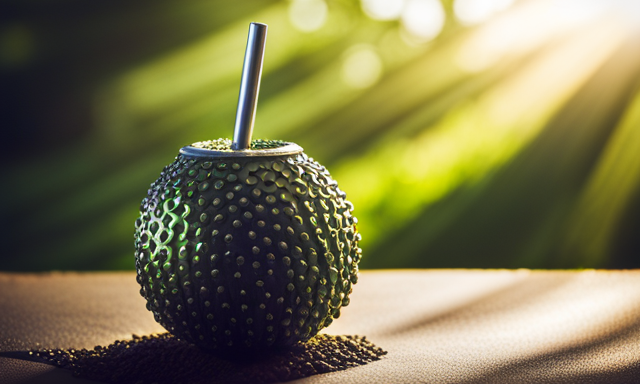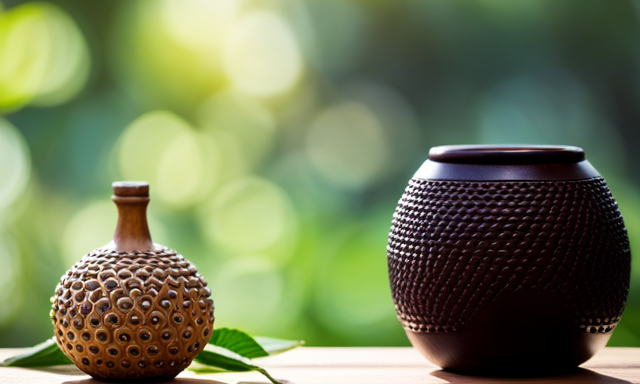I’ve always had a keen interest in Yerba Mate and the deep cultural heritage that surrounds it. Being a tea enthusiast, I’m perpetually on the hunt for fresh and distinctive tea varieties to sample. Yerba Mate captivates me particularly because of its unique taste and the traditional practice of sharing it with friends in South American nations.
But where does this fascinating drink come from? In this article, I will explore the origins of Yerba Mate, how it is prepared, its place in South American culture, and how it has spread around the world.
Yerba Mate is not just a simple beverage; it is deeply intertwined with the history and traditions of many South American countries. By examining the roots of this drink, we can gain a greater appreciation for its significance to those who have enjoyed it for centuries. Additionally, understanding where Yerba Mate comes from can help us appreciate the importance of sustainability when sourcing this beloved herb.
Join me as we dive into the fascinating world of Yerba Mate and uncover its origins!
Key Takeaways
- Yerba mate is a popular South American beverage made from the leaves of the Ilex paraguariensis plant.
- It has been consumed for centuries by indigenous communities and is typically enjoyed using a gourd and bombilla.
- Yerba mate contains caffeine, theobromine, and other stimulants and has health benefits such as antioxidants, aiding in digestion, and contributing to weight loss.
- Yerba mate is native to South America, specifically the subtropical regions of Argentina, Brazil, Paraguay, and Uruguay, and has immense cultural significance in the region.
Overview of Yerba Mate
Yerba mate is a popular South American beverage made from the leaves of the Ilex paraguariensis plant. It has been enjoyed for centuries by indigenous communities and is now gaining popularity worldwide due to its cultural significance and various health benefits.
It is typically consumed using a gourd and bombilla, which is a straw with a filter at the end that strains out any loose particles. Yerba mate contains caffeine, theobromine, and other stimulants that provide an energy boost without the jitters commonly associated with coffee.
The health benefits of yerba mate are numerous. It contains antioxidants that can help prevent cancer and cardiovascular disease. Additionally, it has anti-inflammatory properties that may help reduce inflammation in the body. Yerba mate also aids in digestion and can contribute to weight loss when consumed as part of a healthy diet.
Popularity and consumption trends of yerba mate have increased significantly in recent years as more people become aware of its potential health benefits. It has gained popularity not only in South America but also throughout Europe, Asia, and North America. In some countries such as Argentina and Uruguay, yerba mate is considered a national drink and integral part of social customs.
With its rich history dating back to pre-Colombian times, yerba mate has played an important role in South American culture for centuries. But where did this beloved beverage originate? Let’s take a closer look at the origins of yerba mate to understand how it became so ingrained in South American traditions today.
Origins of Yerba Mate
The South American indigenous peoples have a long history of consuming the stimulating beverage made from the leaves and stems of a plant native to their region. This plant is known as yerba mate and has cultural significance in countries such as Argentina, Paraguay, Uruguay, and Brazil. The Guaranà people were one of the first groups to cultivate yerba mate, using it for its medicinal properties.
According to historical records, yerba mate was consumed by indigenous peoples in South America long before the arrival of Europeans. It was used both for its stimulant properties and for its medicinal benefits, which included pain relief and improved digestion. Over time, as colonization spread across South America, yerba mate became an important commodity in international trade.
Today, yerba mate remains an integral part of South American culture. It is often shared among friends and family members during social gatherings or meetings. Its use has also spread beyond South America to other parts of the world where it is enjoyed for its unique taste and health benefits. As we delve further into understanding this plant’s origins, let us take a closer look at how it grows and what makes it so special.
Yerba Mate Plant
You’re in for a treat as we explore the vibrant and lush landscape where this beloved plant grows, with its leaves bursting forth like fireworks on a summer night. Yerba mate is native to South America, specifically the subtropical regions of Argentina, Brazil, Paraguay, and Uruguay. The plant thrives in areas with high humidity and rainfall, making it an ideal crop for these regions.
Yerba mate is a member of the holly family and can grow up to 15 meters tall. It has small white flowers that bloom in the spring and summer months. The leaves are harvested from the plant’s branches and then dried over fire or hot air before being packaged for consumption. This production process gives yerba mate its distinct smoky flavor.
Aside from its delicious taste, yerba mate also boasts numerous health benefits. It contains antioxidants that help protect against cell damage caused by free radicals. Additionally, it contains caffeine which can improve mental alertness and focus. Drinking yerba mate has also been linked to improved digestion and reduced inflammation.
As we’ve learned about the yerba mate plant itself and its many health benefits, let’s now move on to how it’s prepared for consumption.
Preparation of Yerba Mate
Growing up in South America, it was a common sight to see people gathered around a fire pit, passing around a gourd filled with steaming hot mate. Yerba mate is not just a drink, but it’s also an important part of the social fabric. The preparation of yerba mate requires traditional gourds and bombillas, which are metal straws used for sipping the tea-like infusion.
The preparation of yerba mate follows certain rituals and etiquette. The first step is to fill the gourd with yerba mate leaves until it reaches about three-quarters full. Then you insert the bombilla into the gourd and add hot water (not boiling) to just cover the leaves. After that, you sip on it through the bombilla until there’s no more liquid left in the gourd. This process can be repeated several times until all of the flavors have been extracted from the leaves.
Yerba mate is deeply ingrained in South American culture as a symbol of friendship and community. People use it as an excuse to get together and share stories or simply enjoy each other’s company. It’s customary to pass around one gourd among friends or family members without cleaning between servings – this represents trust and unity among those sharing it. In conclusion, yerba mate is more than just a beverage; it’s an embodiment of social unity and tradition that has been passed down from generation to generation in South America.
Yerba Mate in South American Culture
Part of the allure of yerba mate in South American culture lies in its ability to bring people together and foster a sense of community through shared experiences. Yerba mate is not just a beverage; it’s a social drink that has been enjoyed by millions in South America for centuries.
Sharing yerba mate with friends and family is an important part of everyday life in many countries such as Argentina, Uruguay, Paraguay, and Brazil.
The cultural significance of yerba mate goes beyond just being a social drink. It is deeply rooted in the traditions and customs of South American indigenous communities who’ve been consuming it for generations. Yerba mate plays an important role in their spiritual practices, rituals, and ceremonies. For these communities, yerba mate is not just a drink but also a symbol of unity, friendship, respect for nature, and connection with their ancestors.
Yerba mate holds immense cultural significance in South American society as it serves not only as a delicious beverage but also as a means to connect with others and maintain longstanding traditions. Its social aspect has made it one of the most recognizable symbols of South American culture worldwide.
As we delve into the history surrounding this beloved beverage next, we’ll explore how it arrived on the shores of South America from its origins abroad.
Yerba Mate in History
As I sip on my yerba mate, I can’t help but wonder about its origins. Yerba mate has long been a staple in South American culture, as we discussed in the previous section. However, its history dates back even further.
The Guarani people of Paraguay and Brazil were among the first to discover the medicinal properties of yerba mate. They believed it had healing powers and used it for various ailments.
In the 16th century, Spanish colonizers observed the indigenous peoples’ use of yerba mate and began cultivating it themselves.
By the 17th century, yerba mate had become a popular drink among European settlers in South America, leading to an increase in production.
Today, yerba mate continues to hold cultural significance for many South Americans. It is often consumed during social gatherings and is viewed as a symbol of hospitality and friendship.
But beyond its cultural importance, yerba mate also boasts numerous health benefits such as providing energy without jitters or crashes, aiding digestion and boosting immunity due to its high levels of antioxidants.
With all these factors considered, it’s no surprise that yerba mate has gained popularity around the world. But how exactly has this traditional drink made its way into other cultures? Let’s explore further in our next section about ‘yerba mate around the world’.
Yerba Mate Around the World
It’s fascinating to see how yerba mate has spread across the globe, capturing the hearts (and taste buds) of people from all walks of life. The cultural significance of this drink cannot be overstated.
Originating in South America, yerba mate was a staple beverage for indigenous communities long before it gained popularity in other parts of the world. Today, it is enjoyed by millions worldwide and has become an integral aspect of many cultures.
Aside from its cultural significance, yerba mate is also renowned for its health benefits. Packed with antioxidants and nutrients such as vitamins B and C, yerba mate is said to boost energy levels, improve mental clarity, aid digestion, and even promote weight loss. Many people swear by the drink’s ability to provide a natural caffeine boost without the crash that comes with coffee or energy drinks.
As someone who enjoys exploring different cultures and trying new things, I can attest to the allure of yerba mate. Whether you’re sipping it on a cold winter day or enjoying it ice-cold on a hot summer afternoon, there’s something undeniably appealing about this unique beverage.
In the next section, we’ll delve into the different varieties of yerba mate available today – each with its own distinct flavor profile and history.
Varieties of Yerba Mate
The diverse range of yerba mate varieties available today offer a nuanced glimpse into the cultural histories and flavor preferences of different regions. Traditional consumption of yerba mate has been an integral part of South American culture for centuries, with different methods and rituals varying from country to country.
For example, in Argentina, the traditional way to prepare yerba mate is in a hollowed-out gourd with a metal straw called a bombilla, while in Uruguay it is common to drink it through a sugar cube held between the teeth.
In recent years, modern variations of yerba mate have emerged that cater to different tastes and dietary needs. Some companies have introduced flavored blends like lemon or mint, while others have added functional ingredients like caffeine or probiotics. Additionally, there are now ready-to-drink options available in cans and bottles for convenient on-the-go consumption.
As the popularity of yerba mate continues to rise globally, it’s important to consider its impact on sustainability. The increasing demand for yerba mate has led to deforestation and monoculture plantations that could threaten the long-term viability of this beloved drink. Therefore, it’s crucial for companies and consumers alike to prioritize sustainable practices such as agroforestry and fair labor standards when producing and purchasing yerba mate products.
Sustainability and Yerba Mate
You might be surprised to know that the increasing demand for yerba mate has led to deforestation and monoculture plantations, putting this cherished drink at risk. The environmental impact of the production of yerba mate is a growing concern among consumers who want to enjoy their beverage without contributing to the destruction of ecosystems.
Sustainable practices are crucial to ensure that we can continue drinking yerba mate in the future. To address these concerns, many companies are implementing sustainable and fair trade practices in their production processes. By supporting these companies, you can help reduce the negative impact on the environment caused by yerba mate production.
Some of these practices include reforestation efforts, organic farming techniques, and fair wages for workers. In addition, it’s important to choose yerba mate brands that prioritize sustainability and fair trade over simply meeting consumer demands. This means looking for certifications such as USDA Organic or Fair Trade Certified labels on packaging.
By making conscious choices when purchasing yerba mate, we can support environmentally responsible practices and ensure that this beloved beverage continues to thrive for generations to come.
Frequently Asked Questions
What are the health benefits of drinking yerba mate?
Drinking yerba mate has been linked to a variety of health benefits, including weight loss and improved mental focus. Studies have found that the caffeine and other compounds in yerba mate can help increase metabolism, suppress appetite, and promote fat loss.
Additionally, the antioxidants in yerba mate may protect against oxidative stress and inflammation, which are associated with numerous chronic diseases. Some research also suggests that the caffeine in yerba mate may enhance cognitive function by improving attention, memory, and reaction time.
Overall, while more research is needed to fully understand the potential health benefits of drinking yerba mate, it appears to be a promising natural supplement for those looking to support their weight loss goals and improve mental performance.
How is yerba mate traditionally consumed in South America?
Yerba mate is traditionally consumed in South America through a communal gourd called a mate. The mate is typically passed around a group of people, each taking turns drinking from the same straw, which is known as a bombilla.
There are certain gourd etiquette rules that are followed when participating in this communal activity, such as never moving the bombilla and only adding hot water to the mate when it becomes necessary.
This social significance of sharing yerba mate is an important aspect of South American culture and has been practiced for centuries.
What are some common misconceptions about yerba mate?
When it comes to yerba mate, there are several misconceptions that people often have. For starters, many believe that it contains caffeine levels similar to coffee, but in reality, yerba mate actually has less caffeine than coffee and is instead high in other stimulating compounds such as theobromine and theophylline.
Another common misconception is that yerba mate can only be consumed hot, when it can actually be enjoyed cold as well. Additionally, many assume that yerba mate is solely a South American beverage, but in reality, it’s also enjoyed in parts of Europe and even the Middle East.
Surprising facts about yerba mate include its high antioxidant content and potential health benefits such as reducing inflammation and improving digestion. Overall, understanding these misconceptions and surprising facts can help broaden one’s knowledge on this popular South American beverage.
How has the production of yerba mate evolved over time?
Yerba mate production has evolved significantly over time, with modern techniques replacing traditional methods in many cases. While traditional methods involved manually harvesting and drying the leaves, modern techniques use machinery to speed up the process.
However, these modern methods have raised sustainability concerns as they require significant amounts of water and energy. Many farmers are now turning back to traditional methods or using a combination of both to maintain ecological balance while still meeting demand.
Overall, there’s a need for more sustainable practices in yerba mate production to ensure its long-term survival as a global commodity.
What are some cultural traditions associated with drinking yerba mate?
Let me tell you about the cultural traditions associated with drinking yerba mate. It’s not just about sipping a hot beverage, it’s an experience that brings people together and creates a sense of community.
When sharing yerba mate, there are certain customs to follow such as passing the mate gourd clockwise and never adjusting the bombilla once it’s placed in the gourd. These small details may seem insignificant but they’re crucial for maintaining etiquette and showing respect to those around you.
Drinking yerba mate is more than just a drink, it’s about building relationships and fostering connections with others. So next time you’re offered a sip from someone’s mate gourd, remember that it’s not only about enjoying the taste but also embracing this rich cultural tradition.
Conclusion
In conclusion, learning about the origins of yerba mate has been a fascinating journey for me. I discovered that it came from the South American rainforest and played an important role in the region’s culture and history.
It was interesting to learn how the plant is traditionally prepared and consumed, as well as how it has become popular around the world. One statistic that stood out to me was that Argentina alone produces approximately 300 million kilograms of yerba mate annually. This is equivalent to over 660 million pounds of yerba mate!
This image really puts into perspective just how much this drink is enjoyed not only in South America but globally as well. It’s amazing to think that such a small plant can have such a huge impact on people’s lives and cultures around the world.
Overall, discovering more about yerba mate has made me appreciate this unique drink even more. From its rich cultural history to its widespread popularity, there is no doubt that yerba mate holds an important place in our world today.










